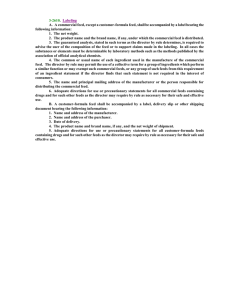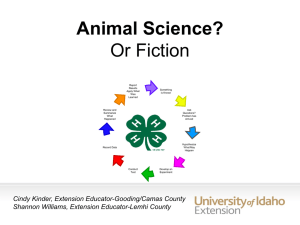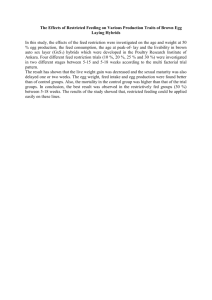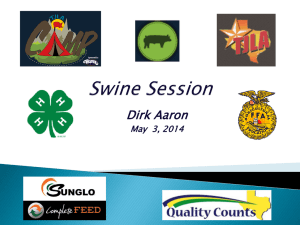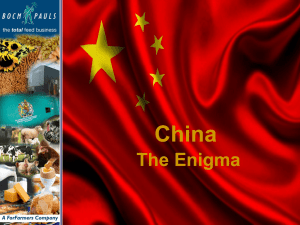Ruminant vs Non
advertisement
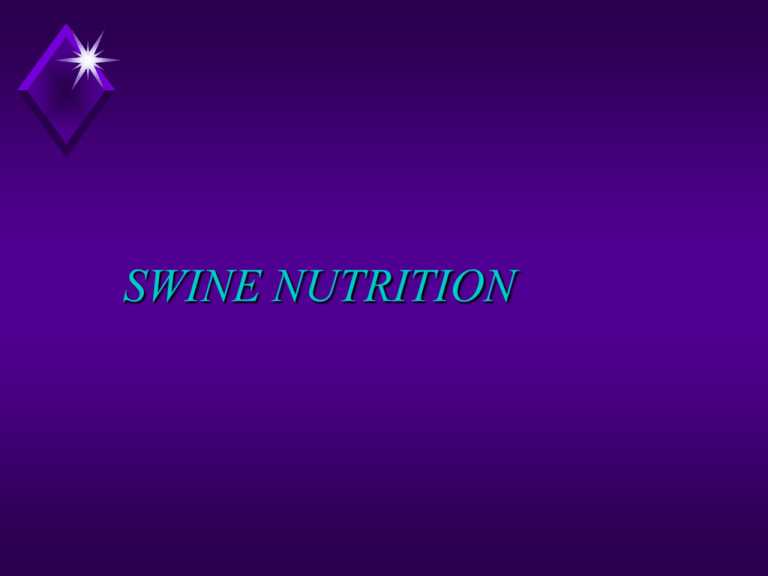
SWINE NUTRITION Single stomach Eat feed low in fiber Humans are also non-ruminants 1. 2. 3. 4. 5. Mouth Esophagus Stomach Small Intestine Large Intestine Breaks down feedstuffs into ….. simple chemical parts….. so the pig can absorb….. and utilize them . Breaks down feed stuffs by chewing Adds saliva to help in digestion Muscles contract to move the food down to the stomach Adds digestive juices to break down food The small intestine…. Mixes secretions Absorbs nutrients Storage and formation of feces Absorption of water Secretion and reabsorption of electrolytes Non-ruminant Abomasum- true stomach depends on digestive enzymes pepsin, rennin, trypsin, chymotrypsin, HCL Needs energy (fat and CHO), protein (a.a.), minerals (Ca:P 1.2:1 to 1.5:1), vitamins, water, antibiotics and other additives Swine Nutrition Basic diet is Corn and Soybean Meal standard ration based on cereal grains, SBM, vit., minerals, additives majority buys a SBM pre-mix to add to corn or milo Energy sources cereal grains -CHO Fat Protein Cereal Grains- CHO Values corn- 100% energy value - 8% CP wheat - 99% use 12.5 % CP milo - 96% (more variable on protein content) use 8% CP when unknown FEEDS Definition- any ingredients or material fed to animals for purposes of sustaining them Classes of Feeds roughages concentrates by-products protein supplements minerals, vitamins, and additives Swine Nutrition Concentrates - high in energy, low in fiber and < 20% protein corn, barley, milo, wheat, rye, oats thumb rules - ok in P, low in Ca low in vitamins, except for beta carotene (A) protein and minerals are low Corn is high in energy, low in fiber and palatable (7-9% protein) Swine Nutrition Proteins - high in nitrogen protein quality - amino acids essential vs non-essential limiting amino acids (lysine, methionine & typtophan); sometimes threonine Protein Sources Soybean Meal, Fish Meal, Meat and Bone Meal, Peanut Meal; not Cottonseed Meal (gossypol toxicity) NPN= non-protein nitrogen- not for swine or poultry Classes of Feeds Vitamins natural, synthetics water vs fat soluble classification A,D,& E are most common in ruminants A, D, & E and B vit. re needed for nonruminants Vitamins Riboflavin Niacin Pantothenic Acid B12 Choline Vit A E Minerals- need 10 macro or major- Ca, P, NaCl trace - Fe, Cu, Zn, Mg, Si, Se Classes of Feeds Special Fats Feed Feeds and oils (increase calories without bulk) additives increase efficiency of gain, prevent diseases, preserve the feed antibiotics, hormones, paylean, navigator, etc. Swine Creep Feeding start at 3-10 days high protein and sugar switch at 40 lbs adv. - uniformity, increase weaning weight, decreases mortality, scours, weight loss by sow and setback when weaned Swine Feeding Stages starter pig ration at 10- 50 lbs (18%) grower ration at 50 - 100/125 lbs (16%) finishing ration at 125-250 lbs (12-14%) Swine Feeding feed efficiency should be around 3:1 3 lbs of feed to yield one pound of wt. gain full vs limit feeding for growing-finishing replacement gilts should receive 4 lbs/day increase feed 2-3 X during lactation Swine Feeding cont. Sows and boars is condition dependent can add peanut or alfalfa hay (limited) do not over feed Swine Feeding cont. Soft Pork - caused by lower melting points in the makeup of fat caused by feeding certain feeds: ie. too much peanut meal Trichinosis - traditionally garbage fed swine FUNCTION OF FEEDS Maintenance- a ration which is adequate to prevent any loss or gain of tissue in the body when there is no production the difference in energy needs are related to the amount of activity Growth- increase in size of muscles, bones, internal and external parts of the body (the foundation of animal production) Finishing- the laying on or deposition of fat Evaluation of Feedstuffs Physical- stage of plant maturity, foreign material, etc. Cost/Unit of nutrient Protein ex. SBM @ $6.00/cwt. @ 44% c.p. 100 X .44=44 lb of crude protein from cwt of SBM $6.00/44 = $.136 per pound of protein OR $320/ton for 44 % SBM = 2000 X .44 = 880; $320/ 880 = $.36 per pound of protein for corn Evaluation of Feedstuffs observe: palatability, grade, preparation, ingredient combination, and quantity fed Chemical Analysis protein, Digestion proximate analysis fat, moisture, and ash (minerals) trial example Evaluation Measuring of Feedstuffs Energy TDN= sum total of the digestible protein, fiber, and nitrogen free extract, and fat X 2.25 Calorie or Net Energy system Net Energy= gross energy-fecal energy-gaseous energy-urinary energy-heat increment gross energy = combustion heat Evaluation of Feedstuffs digestible energy = portion of gross energy that is not excreted in feces Metabolic energy = portion of gross energy that is not lost in feces, urine and gas heat increment = difference between ME & NE heat unavoidably produced by an animal in digestion and metabolism Pigs: we use DE more often How to Balance a Ration Consideration availability points and cost of feedstuffs moisture content composition of feedstuffs nutrient allowances composition of ration needed How to Balance a Ration Methods Pearson Square Trial and error Net energy Computer Commercial Feed Selection Reputation of the mfg. Needs Feed tag guarantee Flexible formulas Home vs Commercial Mixed Feeds Options commercially prepared purchase grain and add protein supplement use home grown grain and add protein suppl. purchase commercial feed and add only mineral and vitamin pre-mix add all indiv. ingredients Feeding Systems Hand vs Self feeding Self feeding advantages less labor increase feed consumption increase gains and earlier marketing not likely to go off feed time and $$$$ saved by bulk feeding Feeding Systems Self feeding disadvantages unless mixed correctly, animals tend to select grain and discard roughage; therefore, grind it find or pelletizing is essential increase cost, if more concentrate is fed Other pigs- add ground alfalfa Feeding Systems Creep feeding- the supplemental feeding of young nursing animals in an enclosure which is accessible to them but not to their parent gains for young animals are cheap gains due to less fat content in young animals and less consumption/body wt. adv.- increases weaning wt., uniformity, achieve genetic potential, assists first sows, etc. Feeding Systems Feeds should not be abruptly changed Check for Nutrient deficiencies Nutrient Deficiencies Protein depressed appetite, lower energy intake, loss of weight, slower growth, irregular or delayed estrus, reduced milk production Major Minerals Ca & P - rickets (fragile bones) Salt - coarse hair coat, loss of appetite I - goiter, poor growth, listlessness Nutrient Deficiencies Mn - weak legs Zn - rough skin- parakeratosis Fe - anemia Se - white muscle disease Co - weakness, loss of appetite Cu - severe diarrhea, weight loss, rough, coarse, bleached coat, anemia Nutrient Deficiencies Vitamins A - most likely, esp. in confinement animals beta D carotene is essential - rickets, osteomalacia in mature animals E - white muscle disease (Se related) K - Excessive bleeding (coagulant Vit) B & C ruminants (No problem); yet with nonruminants; yes, there can be a problem Nutrient Deficiencies Water source major constituent of the body determined by rate of gain, lactation, reprod, environment, activity, feed intake, etc. salt (>1% = toxic) Nutritional deficiencies come by too little or too moldy (<200 ppm aflatoxin in corn) Preparation of Feeds Coarsesness of grinding- hogs prefer coarse particle size, however, we see an increase FE with decreasing the grind size because of increased digestibility, but too finely ground feeds aggravate the stomach and cause ulcers Preparation of Feeds Pelleting- costly, improves digestibility, size (smaller the better), increases the value of a high fiber diet, improves feed efficiency High moisture or reconstituted- slight increase in FE, yet problems in the summer (mold) Preparation of Feeds Wetting or soaking- decreases wastage, saves labor, increases gains and FE , Yet gets soured in the summer Relative effect of protein deficiency carcass characteristics feed efficiency gain/growth

